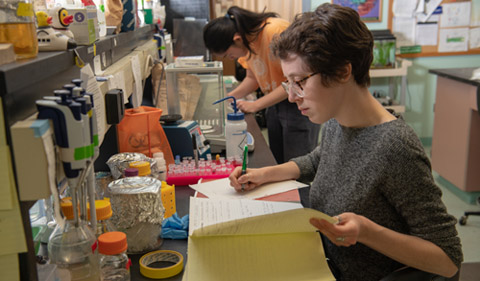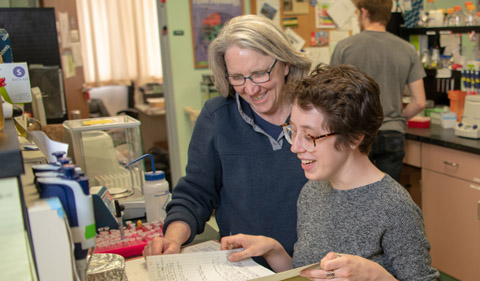Ava Heller’s summer job is researching data from seedlings grown in microgravity aboard the International Space Station.
Already the recipient of the 2019 Norman S. Cohn Research Fellowship in Plant Cell and Molecular Biology, Heller added a prestigious American Society of Plant Biologists Summer Undergraduate Research Fellowship. The fellowship carries a $4,000 summer stipend, membership in the ASPB, and $700 for materials and supplies. Each fellowship also provides a $575 stipend to support student travel to Plant Biology 2020, the ASPB annual meeting, to be held July 25-29, 2020, in Washington, D.C.
Heller is researching “Characterization of AHA2 at the Interface of Gravitropism and Phototropism” in the lab of Dr. Sarah Wyatt, Professor of Environmental & Plant Biology.
“In 2015, Dr. Wyatt had a spaceflight opportunity to conduct a proteomics analysis of Arabidopsis seedlings grown in microgravity aboard the International Space Station (ISS),” Heller says. “Interestingly, the protein AHA2 was found to be differentially phosphorylated in response to spaceflight. AHA2 is a protein proposed to be responsible for the cell wall acidification in plants that allows the plant stem to bend and elongate and usually accompanies early gravitropic response. AHA2’s activity is regulated by phosphorylation of the Cterminal autoinhibitory domain. The phosphorylation of the domain stops autoinhibition, allowing AHA2 to be active. Phosphorylation of this domain was down regulated in response to microgravity aboard the ISS. I plan to assess the importance of AHA2 in plant gravity response, determine if light influences AHA2’s role in this response, and evaluate the importance of the C-terminal domain in the regulation of AHA2 in response to light and gravity.”
“I first met Ava as a freshman in the introductory cell and molecular biology course, Foundations of Plant Biology,” notes Wyatt. “Even as a freshman, it was clear to me that she would be successful. She came to talk with me almost immediately about volunteering in the lab and has worked in the lab ever since, first as a volunteer, then as a PACE student. She has a solid foundation in plant biology and in molecular biology through both coursework and laboratory experience. She has presented her previous research at local and national meetings and is working on a short first author manuscript on that work.”





















Comments